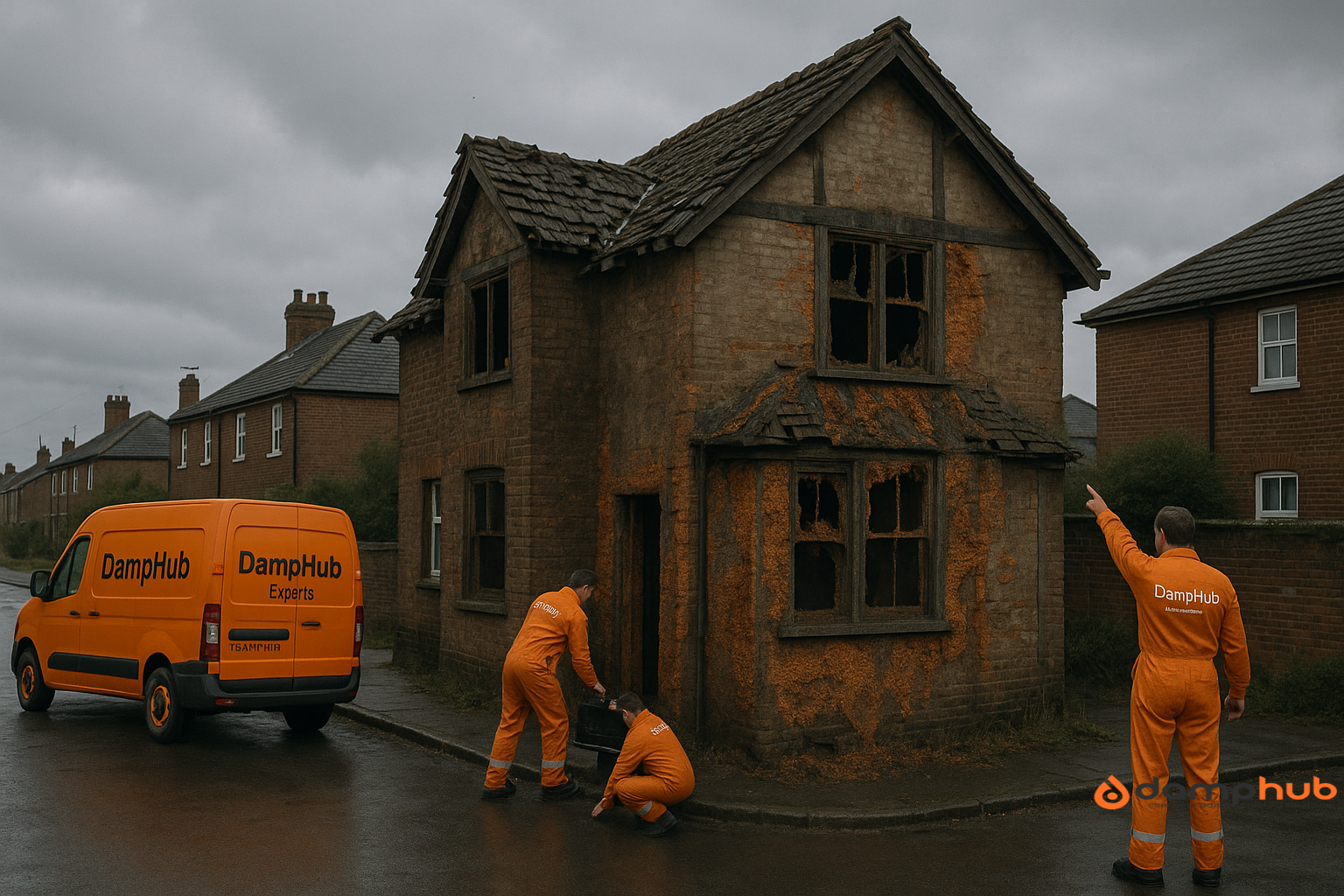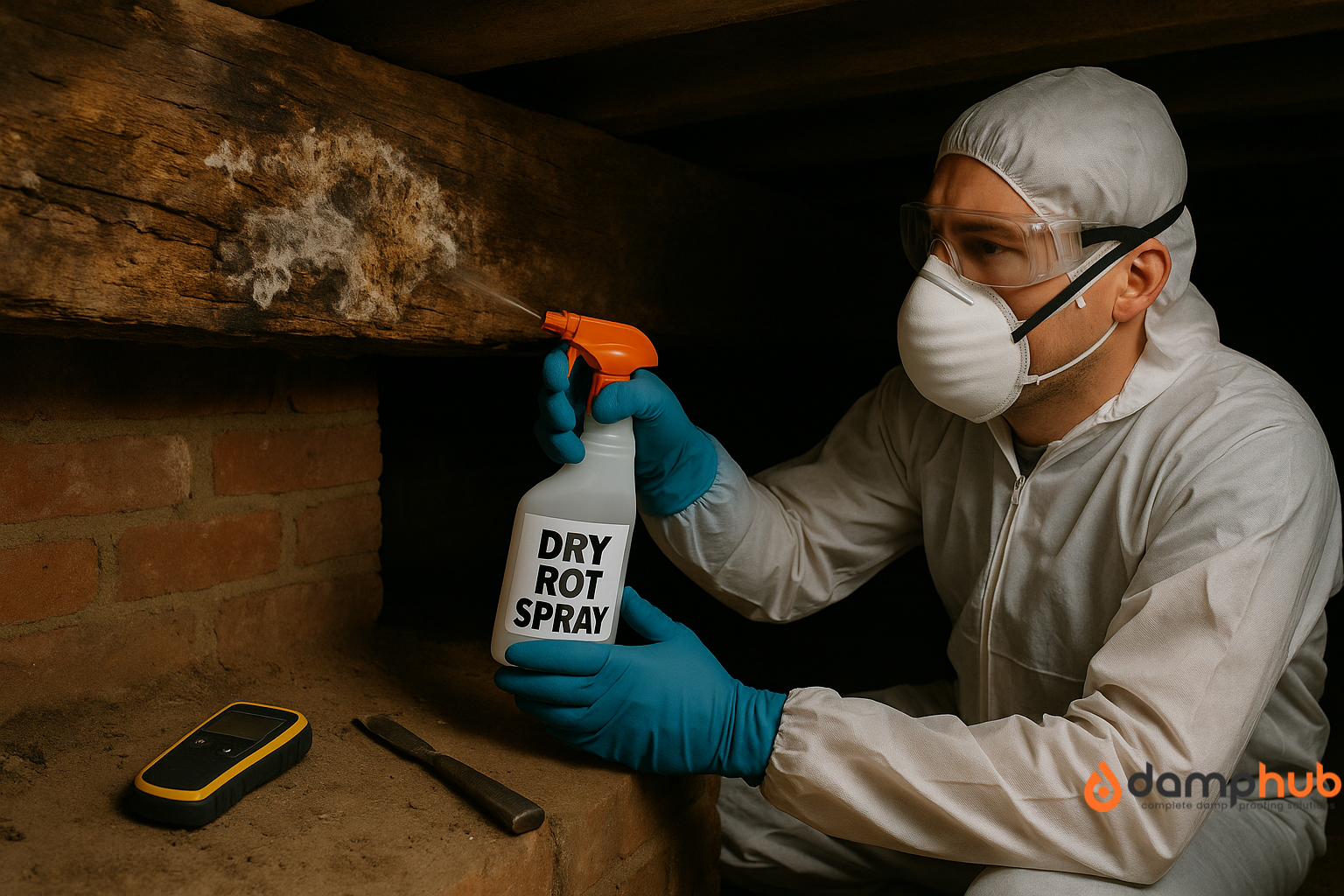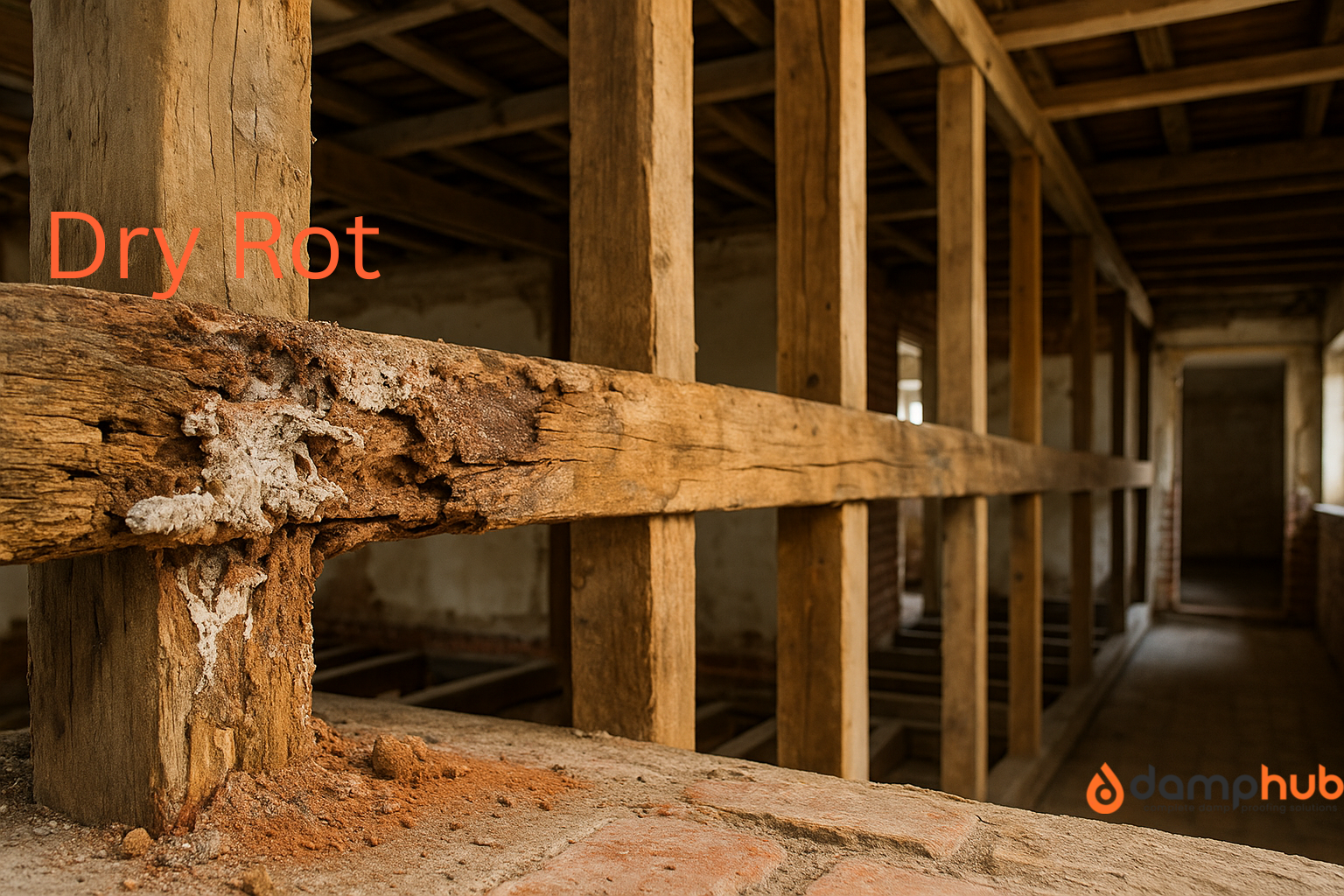
Key Takeaways
- Dry rot = damp + time – Fungus attacks hidden, poorly ventilated timber.
- Spot it early – Soft wood, cuboidal cracks, fungus, reddish dust, musty smell.
- Treatment is full‑fix – Stop damp, cut out rot, treat surrounding areas.
- Prevention saves money – Keep timber dry, ventilated, leak‑free, use treated wood.
- Serious cases need pros – DIY often fails; expert repair keeps structure safe.
Dry rot in structural timber is one of those problems you really don’t want creeping into your home. It’s quiet, sneaky, and doesn’t care how strong your beams used to be.
One week, the place feels fine. The next one, you’re wondering why a bit of timber sounds hollow when you tap it or why that corner of the floor feels different underfoot.
Sometimes it hides up in the loft. Sometimes under the floorboards. By the time you spot it, the damage can be far beyond a weekend job.
In this article, we’ll talk about what it is, how to spot dry rot in structural timber early, and what you can do before it takes hold and ruins your structure.
Related article: Professional vs DIY Dry Rot Treatment: What’s Worth Your Time (and Money)
What Is Structural Dry Rot?
In simple terms, it’s wood rot caused by a fungus called Serpula lacrymans. But not just any bit of wood. We’re talking about the bones of your home — the beams, the joists, the rafters. The parts you really don’t want falling apart.
It tends to appear in areas that remain damp and stagnant for an extended period. I’ve seen it in lofts where a slow roof leak has gone unnoticed for years. Under old suspended floors, where air bricks are blocked. Even in a back room, where condensation and poor ventilation have been a problem.
Once it takes hold, the fungus feeds on the fibres that give timber its strength. Press it with a finger, and the wood can give way. Sometimes it flakes. Sometimes it just collapses like stale cake.
You may notice a reddish tint to the timber. Or a strange, cottony growth. In bad cases, string‑like strands appear, snaking along brick or plaster, looking for the next damp bit of wood.
If that wood is part of your main structure, things can get serious quickly. Floors dip. Doors stick. And in the worst cases, a room becomes unsafe to walk in. Catch it early, and you can deal with it before it goes too far. Leave it, and the repairs can be costly and invasive.
What Causes Dry Rot in Structural Timber?
Dry rot doesn’t appear out of nowhere. It needs two things: damp timber and time. Give it both, and you’ve set the stage for trouble.
In the UK, the odds are in its favour. Our damp climate and older homes give it plenty of places to start — quiet, hidden spots where water lingers. Once timber stays wet long enough, airborne spores land and get to work.
Here are some of the main causes of dry rot in structural timber:
- Roof leaks: A slipped tile or cracked flashing is all it takes. Rain finds a way in, runs along rafters, and soaks timber at the far end where no one’s looking.
- Gutters and downpipes that fail: Blocked, split, or badly fitted. Instead of taking water away, they dump it down walls. The brickwork soaks it in and passes it to the timbers.
- Leaky pipes: Not the big bursts — the tiny, hidden leaks under floors or behind walls. They keep timber damp for months before you even know they’re there.
- Blocked air bricks: Under a suspended floor, fresh air is essential. Block the vents, and the space stays damp, giving fungus a perfect home.
- Rising damp: Moisture creeping up through walls can reach joists and wall plates, especially when they’re built into the brickwork.
- Condensation: Cold, unused rooms often trap moisture. Without airflow, it slowly seeps into the timber.
🟠 Good to know
- ✓ Dry rot spores are everywhere. Keep timber dry, and they stay harmless.
How Do You Identify Dry Rot in Timber?
Dry rot doesn’t wave a flag when it moves in. It hides in quiet places — under a floorboard you never lift, behind the skirting in the spare room, or in the darkest corner of the loft. But it does leave a trail if you know where to look.
Dry Rot In Timber: Signs to Watch For
- Timber that gives way under pressure: Test suspect spots by pressing with your thumb or the flat end of a screwdriver. In sound wood, it will spring back. In dry‑rotted timber, it feels soft, sometimes spongy, and may crumble at the surface. Floor joists under old carpets and skirting boards in damp rooms are common trouble spots.
- Unusual cracking along the grain: Dry rot often creates sharp splits running with the grain, breaking the wood into small rectangular “blocks.” Look for this on the side of joists in the loft, on the back edge of door frames, or in floorboards near external walls.
- Reddish‑brown patches in the wood: The fungus can stain timber a dull reddish‑brown, sometimes mixed with grey. This is often seen on the underside of floorboards, in roof timbers near a leak, or on joist ends built into walls.
- Cotton‑wool‑like growth: White or grey fluffy patches may form where the fungus is feeding. This can appear under kitchen floors near leaky pipes, behind skirting boards in damp rooms, or around window frames with condensation issues.
- White, string‑like strands: The fungus sends out fine threads that can stretch across brick, plaster, or even concrete to reach more timber. Check under floorboards, in cellar ceilings, or along loft beams close to damp areas.

- A persistent musty, mushroom‑like smell: Often stronger in one corner of a room, behind a cupboard, or in an enclosed space like a cellar. If the smell lingers even after cleaning and drying, it’s worth investigating.
- Floors that dip or doors that stick: Weakened joists or floorboards can cause slight sagging. This can make a floor feel uneven underfoot, or a door catch on the floor or frame — especially in older rooms with timber floors.
Read our full guide: Identifying Dry Rot Symptoms
💡 Pro Tip
- ✓ Never scrape or break into suspect wood to check what’s inside. This can release more spores and help the fungus spread. Always confirm with a qualified damp or timber specialist before disturbing it.
How Do You Treat Rotten Timber?
Dry rot treatment is not just about fixing what you can see. By the time you notice it, the fungus may have already travelled further than you think. If you only patch the obvious bit, it will almost certainly come back.
Here is how to properly deal with dry rot in structural timber.
- Find and stop the moisture source: Dry rot needs damp to survive. If you do not deal with what is making the timber wet — whether that is a slow leak in the roof, a plumbing drip under the floor, or blocked ventilation — it will simply grow again. This is always the first step.
- Cut out affected timber: Rotten wood cannot be saved. It needs to be removed well past the visible damage because the fungus can run through the wood beyond what your eyes can see. In some cases, whole beams, joists, or roof timbers have to be replaced.
- Treat nearby materials: The fungus can creep into brickwork, plaster, and other pieces of timber close to the main outbreak. These areas are treated with a strong fungicidal solution to kill any hidden spores before they have a chance to start up again.
- Improve ventilation: Good airflow keeps spaces dry. Lofts, underfloor voids, and other closed areas should be checked for blocked air bricks or vents. Opening these up or adding extra ventilation makes it much harder for dry rot to return.
- Replace with treated timber: Any new timber that goes in should be pre‑treated or pressure‑treated to help protect it from another fungal attack. This is a small extra step that makes a big difference.
- Inspect other areas: If you have found dry rot in one spot, there is a chance it is starting somewhere else under similar conditions. A careful check now can prevent another costly repair later.
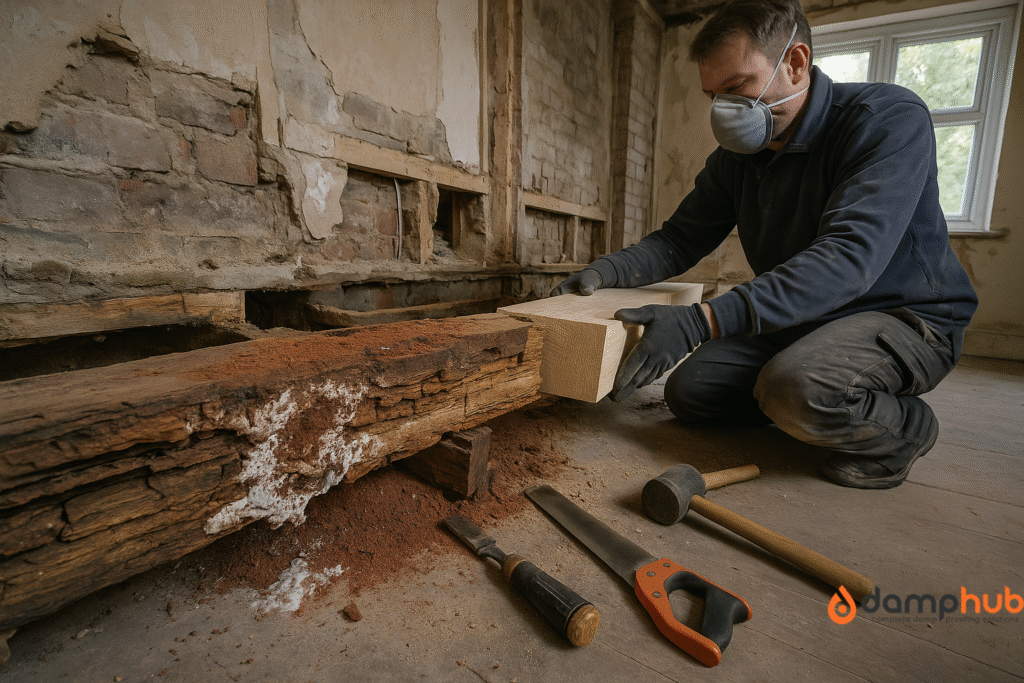
🟠 Good to know
- ✓ Dry rot treatment is not the kind of job you can half‑do. Once you have it, it needs to be removed completely, or it will be back. Getting the source of damp sorted and using the right treatment from the start saves a lot of money and hassle.
How Do You Prevent Dry Rot in Timber?
Stopping dry rot in structural timber is easier than fixing it after the fact. Once it’s in there, it’s a pain — and it’s expensive. So you’re better off making sure the fungus never gets the damp, stale conditions it needs.
Here’s how to prevent dry rot in structural timber:
- Keep timber dry: Sounds obvious, but most people only notice a leak once it’s dripping on their head. A slipped roof tile, a dodgy gutter joint, even a tiny pipe drip under the floor — they all give dry rot in structural timber exactly what it wants.
- Let air move: Rot loves a stale, still space. Lofts, under‑floor spaces, cellars… if air’s not moving, damp just sits there. Clear blocked air bricks, get vents open, even add a few more if the place feels stuffy.
- Don’t forget the hidden spots: This is where it often starts. Under the stairs, behind boxes in the loft, around joist ends where they vanish into walls. Check these every so often. You’re looking for any hint of damp or softness before it becomes a bigger job.
- Control condensation: A cold, unused room with no ventilation is practically an open invitation. Keep trickle vents open, use the extractor in the bathroom and kitchen, and don’t let rooms sit unheated all winter.
- Use treated timber when you can: If you’re replacing beams or joists, choose pre‑treated timber. It’s got built‑in resistance to fungal attack, so it buys you time if moisture does find a way in.
- Look after your walls: A cracked bit of pointing, damaged render, or loose flashing might not seem like much, but it’s how water sneaks in. Once it’s in the wall, it can travel to the timber — and then you’ve got trouble.
💡 Pro Tip
- ✓ Make prevention part of your normal maintenance. Quick check of the roof and gutters in autumn, a look at ventilation in winter, and you’ll massively cut the chances of ever having to deal with dry rot in structural timber.
How Long Does Dry Rot Treatment Last?
Treating dry rot in structural timber isn’t a five‑minute job. The time it takes depends on how far the fungus has spread and how much of the structure it has damaged.
- Small, localised cases: A few days. If the rot is caught early and only affects a small area, it can be removed and replaced fairly quickly — often within two or three days once the source of damp is fixed.
- Moderate outbreaks: One to two weeks. This is more common. It usually means cutting out larger sections of timber, treating surrounding masonry, and improving ventilation.
- Severe structural damage: Several weeks. If main beams, joists, or roof timbers are heavily affected, the job can involve significant structural repairs. In older buildings, this can stretch to a month or more, especially if specialist joinery is needed.

🟠 Good to know
- ✓ The actual treatment stage is only part of the timeline. Finding and fixing the moisture source often takes as long as the removal itself — and without that step, the rot will just return.
Related post: 7 DIY Wet Rot Prevention Tips
Does Dry Rot in Structural Timber Come Back After Treatment?
It can — but it doesn’t have to. Whether dry rot in structural timber returns depends entirely on how well it was treated the first time and whether the conditions that caused it have been fixed.
If the damp is gone: No. Once the timber is dry and stays that way, the fungus can’t survive. A thorough treatment that removes all affected wood, treats surrounding areas, and stops the source of moisture will keep it away.
If the damp comes back: Yes. A new leak, blocked gutter, or poor ventilation can undo all the work. Spores are always around in the air, so the moment timber becomes damp again, they can start growing.
If the job was only half‑done: Almost certainly. Cutting out the visible rot but leaving hidden strands in nearby timber or masonry is asking for trouble.
🟠 Good to know
- ✓ Dry rot treatment is only as permanent as your moisture control. Keep the structure dry and you’ll likely never see it again. Let damp sneak back in, and it’s only a matter of time before it reappears.
When Should You Call a Professional for Dry Rot?
Some dry rot is the kind you can tackle on your own. A bit of skirting board that’s starting to crumble. A loose floorboard by the door that’s soft to the touch. Small jobs like that can be cut out, replaced, and painted over in an afternoon.
But dry rot in structural timber is another matter entirely. This is the timber that holds up your floors, roof, and walls. If that starts to go, the safety of the building is on the line. You can’t just patch it and move on.
You need to know exactly how far it’s spread, whether the structure is still sound, and how to stop it for good. That’s where a professional earns their keep.
Here’s when it’s worth calling a dro rot professional:
- When the structure might be at risk: If beams, joists, or roof timbers are affected, stop guessing. Get someone in who knows how to check them properly.
- When the source of damp is a mystery: You might poke around and find nothing. A pro has the tools to track down hidden leaks and measure moisture inside the timber itself.
- When the rot isn’t just in one spot: It can travel quietly through timber, along brick, even behind plaster. If you’ve got it in more than one place, you need a full inspection.
- When the property is older: Older homes hide all sorts of problems in roof spaces, under floors, and behind walls. A specialist will check them without causing damage.
- When it keeps coming back: If you’ve “fixed” it before and it’s returned, the real cause was never sorted. A professional will get to the root of it.

💡 Pro Tip
- ✓ Not sure? Play it safe. Having dry rot in structural timber checked early is always cheaper than rebuilding a floor or roof later.
How Much Does It Cost to Repair Dry Rot in Structural Timber?
Repairing dry rot in structural timber can vary a lot, depending on how deep the damage goes and how tricky the fix is. Here’s a clearer breakdown of the amount you’ll typically need to treat dry rot in structural timber:
💰 How Much Does It Cost to Repair Dry Rot in Structural Timber?
| Job Scope | Typical UK Cost Range | What’s Involved |
|---|---|---|
| Very small local fix (e.g. skirting, window sill or trim) | £500 – £1,500 | Non-structural elements only: sand out rot, apply fungicide, replace a short timber section. No damp repairs usually needed. |
| Local structural repair (e.g. joist ends, single joist) | £1,500 – £5,000 | Replacing one or two short structural timber pieces, treating surrounding areas, fixing damp/ventilation in that room. |
| Full-area structural treatment (large section or single floor) | £4,000 – £12,000 | Multiple girders or joists replaced, room-scale fungicidal spray, improved airflow, moisture source fixed. |
| Major structural overhaul (whole floors, roof timbers, heritage build) | £12,000 – £20,000+ | Extensive replacements of beams or rafters, possible structural steel, major damp-proofing and full restoration. Often involves structural engineers and longer guarantees. |
Why the big price range?
- Severity matters – A small patch is simple. Once fungal strands reach roof timbers or spread across multiple rooms, it becomes a major structural issue.
- Location affects access – Repairs under a kitchen floor are far easier (and cheaper) than cutting into beams hidden behind walls or ceilings.
- Fixing the damp source can cost as much as the timber work – Replacing rotten wood is only half the job. Solving the underlying moisture problem is often just as expensive.
- Extra building work can add up fast – Roof replacement, damp‑proof membranes, new air bricks, or sub‑floor ventilation upgrades can push costs much higher.
- Guarantees and insurance – Firms offering 20–30 year insurance‑backed guarantees usually charge more upfront, but you’re paying for the peace of mind that the dry rot in structural timber won’t return.
See our full guide on dry rot treatment costs: Dry Rot Repair Costs in the UK – Full Breakdown for 2025
🟠 Good to know
- ✓ Quotes that look cheap often ignore moisture repair. If the damp isn’t dealt with, dry rot will return. Investing in a thorough fix the first time usually pays off in the long run.
Can Dry Rot in Structural Timber Spread to Other Materials Besides Wood?
Dry rot feeds on wood. But that doesn’t mean it stays neatly tucked inside timber. Once it takes hold, it can push out fine, root‑like strands — called mycelium — that creep far beyond the original patch.
These strands don’t care if they’re crawling over brick, plaster, or even the back of wallpaper. They’re not eating those materials — they’re just using them as bridges to get to more damp wood. In some cases, they can travel several metres across a wall or floor to reach a fresh food source.
The key is moisture. Dry rot in structural timber needs a consistently damp environment to survive. If those strands cross a dry wall, they dry up and die. But if the wall is damp — perhaps from a leak, rising damp, or condensation — the fungus can keep moving and find its next meal.
This ability to travel across non‑wood materials is why dry rot in structural timber can sometimes seem to “appear” in different rooms at once. In reality, it’s often the same outbreak making its way quietly through the building.
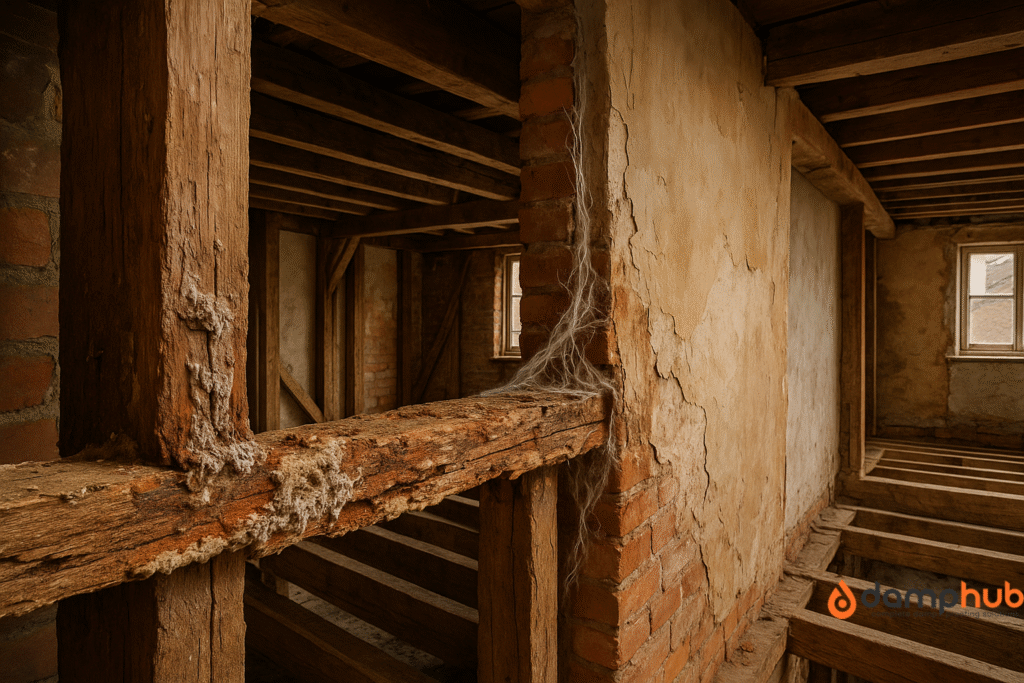
🟠 Good to know
- ✓ If you find dry rot on timber, don’t assume it’s contained. Even if nearby walls and ceilings look fine, the fungus may already have sent out strands in search of more wood. This is why thorough inspection — not just local repair — is so important.
Questions People Ask About Dry Rot in Structural Timbers
-
What are the conditions for dry rot in structural timber?
Dry rot needs two things: damp timber and time. If wood stays wet for weeks or months and there’s poor ventilation, airborne spores can land and start growing.
-
How to prevent wood from rotting naturally?
Keep timber dry and well‑ventilated. Fix leaks quickly, clear gutters, unblock air bricks, and allow airflow under floors and in roof spaces.
Related guide: Dry Rot on Walls: Causes, Signs, and Expert Treatment Advice
-
How to reduce further decay in timber?
Remove the source of moisture immediately, dry the timber thoroughly, and cut out heavily damaged sections. Treat the remaining wood with a fungicidal preservative.
-
What should the moisture content in structural timber be?
For safety, it should stay below 20%. Above this level, conditions are right for fungal growth.
-
Can you paint over dry rot in structural timber?
No. Painting traps moisture inside and hides the problem, allowing the fungus to keep spreading.
-
Can a house collapse from dry rot in structural timber?
Yes, in severe cases. If load‑bearing beams, joists, or rafters are badly decayed, the structure can become unsafe.
-
Is dry rot in structural timber an emergency?
Yes. It weakens structural timber and spreads quickly in damp conditions, so early treatment is essential
-
Is a little dry rot okay?
No amount is “okay.” Even a small patch can spread if the timber stays damp.
-
Can dry rot spread through concrete?
It can’t feed on concrete, but it can grow across it to reach more timber if the surface is damp.
-
How long does it take for dry rot to destroy wood?
In damp, stagnant conditions, it can weaken timber in just a few months and cause serious structural damage within a year.

